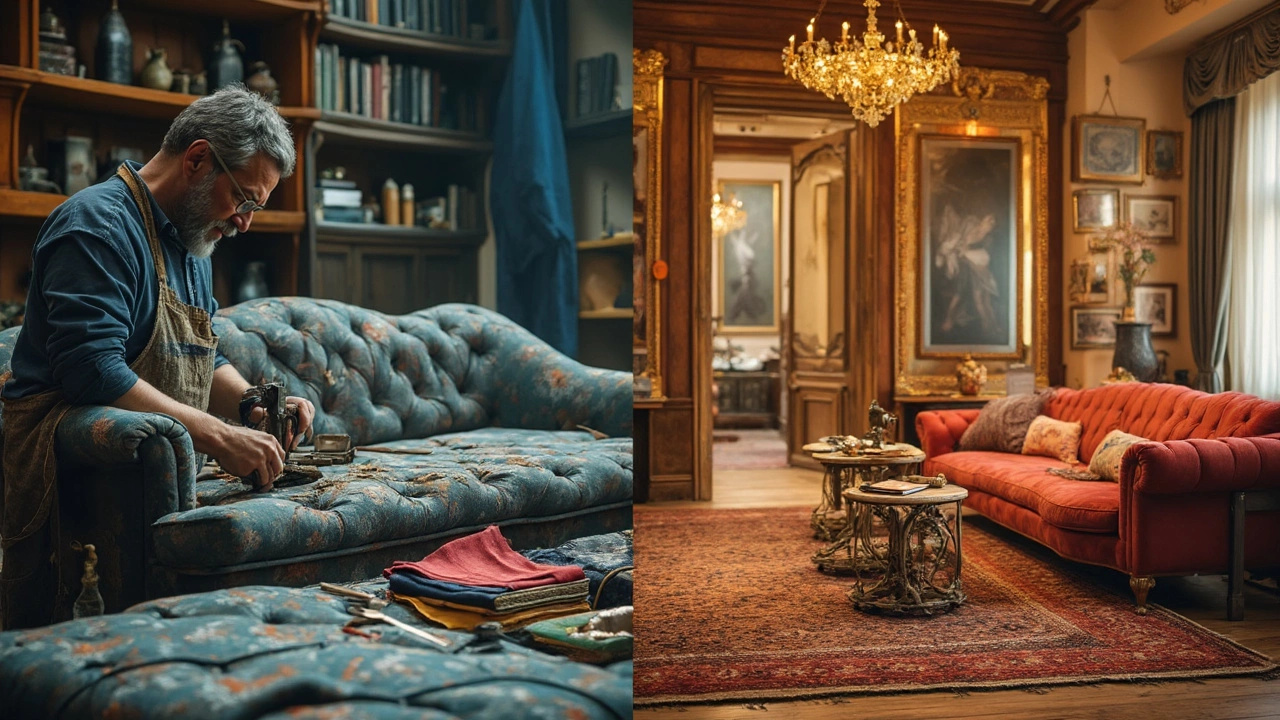So, your couch has seen better days, huh? Before you decide to part ways, there's a big question to tackle: Is it cheaper to reupholster or just buy a new one? Both choices have their own charm, but it's not all about looks.
Let’s talk numbers, because that’s what you're really here for. On average, buying a new couch can set you back anywhere from $500 to over $2,000. Yikes, right? On the flip side, reupholstering costs range between $600 and $1,800, depending on the fabric and the complexity of the job. Not a huge difference there!
But here's the kicker—materials matter. Picking a durable, chic fabric for reupholstering might cost you less in the long run than constantly replacing a budget-friendly couch with flimsy cushions. And if you've got a solid frame? You’re golden. Why toss it when you can give it a facelift?
So, whether you're pinching pennies or looking for a living room revamp, weighing these options helps. Next, we’ll dive into durability and what makes sense for your space. Stay tuned!
Comparing Costs
When it comes to figuring out couch cost decisions, a closer look at buying new versus reupholstering is key. Let’s break it down, shall we? It’s like comparing apples to oranges but for living rooms!
On average, a new sofa can cost anywhere from $500 for a basic model to well over $2,000 for something a little more posh. But those bargain finds? They often come with cheaper materials that might not hold up when your family decides to use the couch as a trampoline.
Now, reupholstering is a different game. If you've got a trusty frame, you’re looking at prices ranging from $600 to $1,800. Yeah, it’s not pocket change, but you get to pick the fabric, style, and essentially design a custom piece. It's like giving your grandma’s couch a second life!
To put it into perspective, here's a quick rundown:
- Basic New Couch: $500 - $1,200
- Deluxe New Couch: Over $2,000
- Reupholstery: $600 - $1,800
Time for some number crunching! When you think long-term, reupholstery might save you money because you're not ditching good bones for a flashy new frame. Plus, it's eco-friendly. Keep in mind, though, hidden costs in reupholstery like structural fixes or the little temptation to get fancy with premium fabric could add up.
If this sounds a little overwhelming, check out pros and cons lists for each option to weigh your decision. Money isn’t the only factor—there’s style, sentimentality, and that couch jump test to consider!
Material Considerations
When deciding between a new couch or reupholstering, the material makes a big difference. Let's break it down. First, fabric choice can affect the cost and durability. Fabric stores offer a variety of styles, but remember, not all materials are created equal.
If you're inclined to reupholster, give a nod to heavy-duty options like leather, microfiber, or canvas for your couch cost. These are known for their durability and ease of cleaning, making them a great pick, especially for families with kids or pets.
Considering new? Check for high-quality upholstery with a high thread count and tight weave. It's often worth spending a bit extra for better materials because it means less frequent replacements. A cheap couch might look like a saving, but with wear and tear, it could lose shape quickly.
Here's something interesting: A survey by the Furniture Industry Association found that 40% of people who purchased cheaper couches replaced them within five years, while those who invested in quality material saw twice the lifespan.
Here’s a quick checklist when considering materials:
- How often will this new sofa be used?
- Are spills and stains likely?
- Do you have allergies that require specific materials?
- What's your style preference: trendy or timeless?
Ultimately, this choice impacts the look, feel, and longevity of your space, so weigh it well!

Durability and Longevity
When it comes to deciding whether to buy a new couch or reupholster, one big factor to consider is how long each option will last. Let's face it—no one wants to be couch shopping every few years.
Often, older couches have sturdy frames that are built to last. If that's the case with your current piece, a reupholster might extend its life significantly. Most antique experts believe that a solid hardwood frame can last decades, even outlasting several sets of cushions. A source at Homes & Gardens notes,
“A well-made frame is really what gives longevity to a piece of furniture, making reupholstering a practical choice.”
When it comes to durability, consider also the material of the sofa cushions and upholstery. High-quality fabrics not only make a new sofa look posh but also resist wear and tear. Opt for synthetic fibers or tightly woven fabrics which stand up better to everyday use.
| Option | Average Lifespan |
|---|---|
| Reupholstered Furniture | 10-15 years |
| New Budget Couch | 5-10 years |
| New High-End Couch | 15-20 years |
If you'll mostly be using the couch for lounging (with or without pets and kiddos), getting something with better longevity might save you money and hassle in the long run. No one wants fraying seams and sagging cushions just a few years down the line.
So, if you're eying that vintage piece in the corner, remember it could very well outlast newer ones. But at the end of the day, it all boils down to the materials and craftsmanship, whether you're buying new or reupholstering.
Decision-Making Tips
Confused about whether to go for a new sofa or to reupholster? Let's break it down to make the decision easier for you.
Budget is your first checkpoint. If you’re leaning towards a cost-effective option, compare costs intricately. Don't just consider the upfront prices; think about the long-term implications. For instance, a new couch might seem cheaper initially, but it could require replacing sooner if it's poorly made.
Next, factor in the sentimental value. Got a beloved hand-me-down couch that holds family memories? Reupholstering preserves that emotional connection and freshens it up with modern aesthetics.
Check the sustainability of your choice. Buying a new couch means contributing to manufacturing waste, whereas reupholstering supports a more eco-friendly approach by reusing the existing frame and structure.
Let’s not forget about style flexibility. With reupholstery, you customize your fabric selection, color, and even cushion firmness. On the other hand, buying a new couch restricts you to what's in the market by default.
- If convenience is key, buying a new couch is generally faster; no need to wait for the reupholstering process.
- But if you're picky about design, reupholstering offers more control over every detail.
Think about durability. Investing in high-quality fabric for reupholstering can mean fewer replacements and repairs in the future, even if it's an initially bigger spend.
These tips should help you pinpoint the right investment for your furniture budget. Make a list of what matters most to you—be it price, sentiment, style, or environmental impact—and align your decision with those priorities. Happy couch shopping (or refurbishing)!


